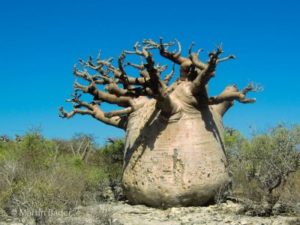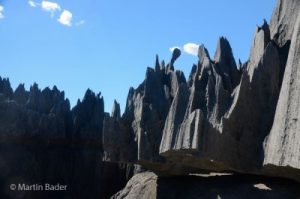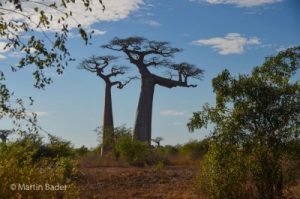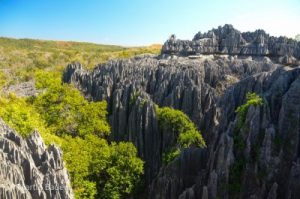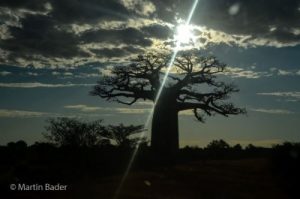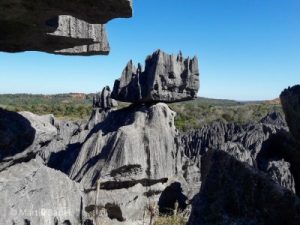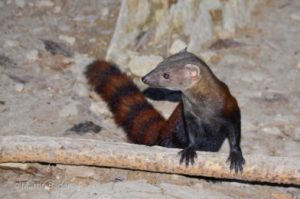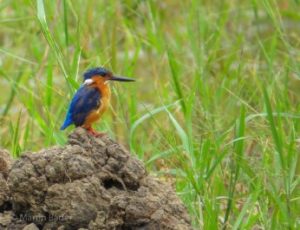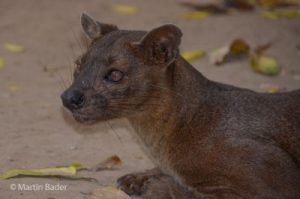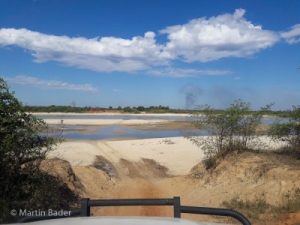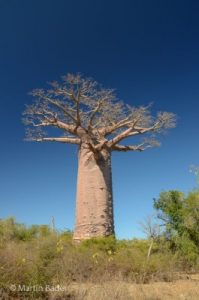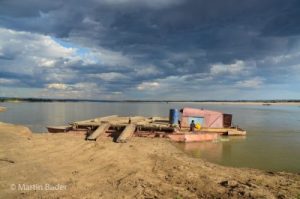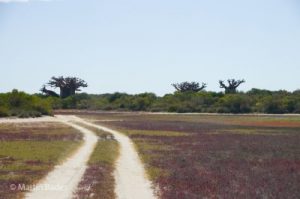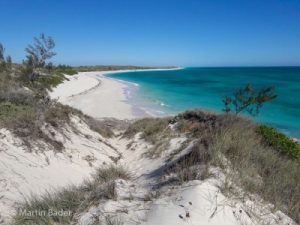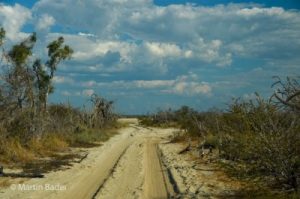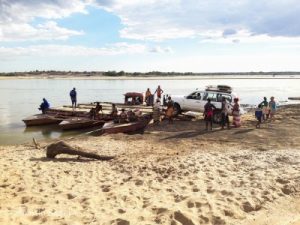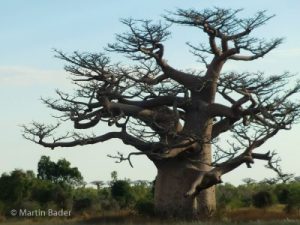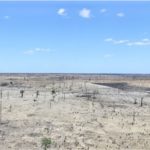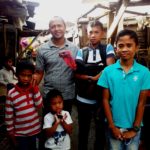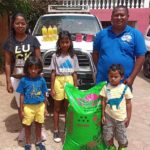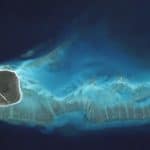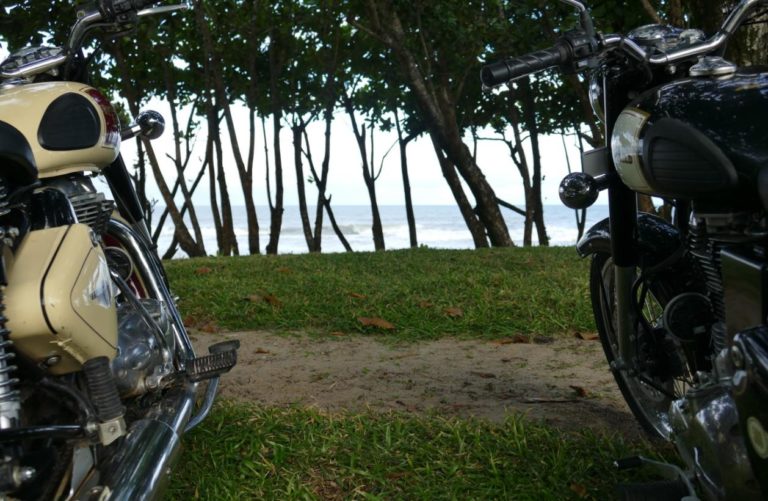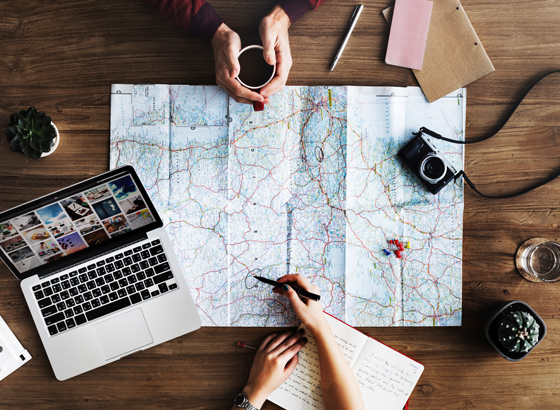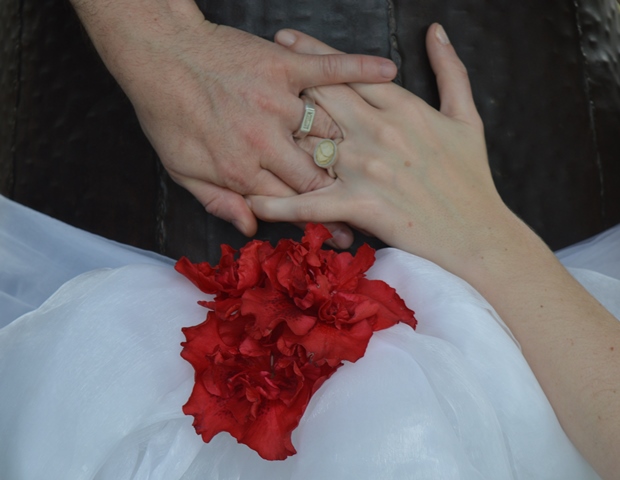4,000 kilometers around the southern half of Madagascar
Part 1- From Antananarivo to Morondava and the Tsingy of Bemaraha
On July 11, 2016 at two o'clock in the morning, we, Martin and Heidi, once again entered the red island in Antananarivo. Ahead of us lay a 27 day adventure with a, specially adapted 4×4 Toyota Landcruiser with driver.
At this point we would like to thank you Klaus, for your organizational and logistical preparations and always good advice.
The adventure begins at the airport upon arrival. We discover that only half of our luggage has arrived. Fortunately, it was delivered with the next machine in the afternoon and off we went to Antsirabe. Overnight stay at the Hotel Chambres du Voyageur with beautifully landscaped garden, which we unfortunately could enjoy only on the way back.
On the 490 km long daily stage to Morondava, we drive through the highlands with breathtaking mountain ranges and river valleys.
The road N34 is mostly well passable and we make rapid progress. Along the village crossings there is always a sociable everyday hustle and bustle. The many small stalls and the large supply of fresh fruit often tempt us to take a short break.
I always welcome a cup of coffee and a piece of sweet fat baked goods.
From the bridges of the many rivers you can often see people washing clothes, which they then spread out to dry on the sandbanks or on the shore. Others go about personal hygiene and playing children pass the time with games.
After about halfway we cross for the first time the Tsiribihina, a large river, with a ferry and without a longer break we continue until shortly before Morondavato still in time, before the sunset the famous Baobab avenue to reach. Already a few kilometers before we see these tree giants along our road lined with lush, yellow-green rice fields.
On arrival, some tourists are already on site and it is hardly possible for me to photograph the avenue without them. Therefore, I preferred to leave the track and photograph these beautiful, slender baobabs from another perspective. Overnight stay in Morondava in the somewhat remote from the city, quiet Kimony Lodge 7:30 departure to Bekopaka, the entrance to the Tsingys from Bemaraha.
There are 235 km of first sandy, then harder and harder, bad dirt road ahead of us. For many kilometers we see areas with bushes. Blackened remains of tree trunks stand like memorials as witnesses of large fires in between and the further we drive to the north, more and more plumes of smoke become visible on the horizon. Before Belo sur Mer we are now driving, almost like in a corridor. In deep sand, hemmed in by four to five meter high dense scrub, passing each other in oncoming traffic is hardly possible and often many locals are on the road in whole groups. Not far and we reach the second time the Tsiribihina and an adventurous ferry takes us in a 20 minute ride across the river to Belo sur Tsiribihina. Along the banks people load their dugout canoes with goods to bring them to the city.
In the center of Belo we have a short lunch break and I have the opportunity to take pictures of the daily hustle and bustle and the market.
The slope becomes harder and after one and a half hours we have reached the smoke clouds seen earlier on the horizon. Small fire nests partially reach the slope. The landscape changes now more and more often from since then open grassy areas with few bushes into wooded areas and have to drive more and more often in depressions through not yet dried up small rivers. At 3 p.m. we then reach the last ferry across the Manambolo and it is only a few kilometers to our hotel in Bekopaka.
Early in the morning we set off for the upper entrance of the Grand Tsingy up. After 23 km, on mostly very bad, hard track, we finally reach a small parking lot, our destination, after one and a half hours. In the shade under trees locals have built a small stand where you can buy homemade juices and various food. Normally only the drivers help themselves to this possibility but I did not let myself be deterred Wild boar with rice to eat and I must say it was very tasty. I can only advise against the use of the toilet. I am used to some, but there even I preferred a bush. After putting on the provided harness (because of the bad condition please bring your own who has!!) and a small instruction, it goes already on tour. After about 15 minutes we come close to a forest that reaches up to the Tsingy. At a great distance are the white sifakas to see in the trees and in the forest also Lepilemur randrianasoloi in the tree.
After a slight ascent in the forest, we already come to the vertical, sharp-edged rock faces with niches, furrows and partly deep crevasses. Secured by steel ropes, it goes steeply up with climbing in the rock and in difficult places are also sometimes ladders or climbing aids. We are rewarded for our efforts with a magnificent view. My gaze sweeps over bizarrely shaped rock needles, deep gorges and the plants and trees growing in them, far into the horizon where red escarpments shine through the forest. After a short rest and many photos, it goes over two suspension bridges in another place again steeply down and we are now at the bottom of a narrow gorge in a grotto.
We rest here a few minutes in the cool shade of the steep rock needles to eat a snack and drink. Suddenly I see a movement about four meters above me on the vertical rock face. Something climbs straight down to us and then I recognize a Ring-tailedmungo (Galidia elegans). He seems to be used to visitors, because he slowly comes closer to a meter, despite the flashlight and noises. Now a second one crawls out of a hole near the ground and they search the ground for something to eat until they suddenly look in the direction of a narrow crevice. A rat with a long, bushy tail comes out. Quick as a flash the mongooses run and chase it along our exit. I hear only a distant squeak and the spook is over.
It is time to leave. While walking through the cool crevices we scare up again and again small birds, which also seek shade from the scorching sun on the surface. Slowly it gets lighter and we reach the exit of this huge rock labyrinth. On the way back to the parking lot through the forest, we see still giants Silk Cuckoo (Coua gigas), Pygmy Kingfisher (Ceyx madagascariensis) and many beautiful butterflies. Back at the parking lot we drive also immediately again the very bad slope back to the hotel. The second day we spend relaxing and exploring the surroundings, because we decided not to visit the small Tsingy because of the extremely exorbitant entrance fees. Other tourists we talked to even decided to just stay at the hotel. I paid for two people, one day, entrance and guide, 250 000 Ariary, which corresponds to the very good rate we had about 70 EUR!
PART 2- FROM THE TSINGY OF BEMARAHA via Kirindy to Morombe
We leave early to get across the river right away with the first ferry. It goes back the same way until about 60 km before Morondava. A small dirt road branches off to the east and after about 7 km we reach Kirindy later in the afternoon. I am a bit disappointed as the camp is a construction site at the moment. The accommodations are plain and very simple, but that doesn't bother me. For me personally the reason for the Visit from Kirindy actually only, the possibility Fossas (Cryptoprocta ferox) to see. A guide tells me that there are currently up to five fossa around the lodge. We move into our cabin and explore the surroundings a bit. Some chameleons, insects and birds can be seen. Now the office is open and we sign up for a night walk at dusk. We decide to rest a bit before and go back to our accommodation. Past the restaurant, around the corner - WOW it's hard to believe! A big fossa male comes out of the forest directly towards us! With one leap it jumps on a container in which there is waste from the kitchen and rummages for food. With some leftovers from a slaughtered chicken, the predator disappears under a hut. No sooner has it disappeared than a second, slightly smaller one comes from another direction with a quick sneak and disappears under the hut as well. Both fossas chase out, a short scuffle, one disappears in the forest, one again under the hut and the whole spook is over. But now we quickly order dinner, get cameras and flashlights and we also go with the car and guide a little deeper into the forest. We go crisscross about one and a half hours through the forest.
Unfortunately we have no great luck a few sleeping birds, a nocturnal large lemur and far away a Mausmaki. On the ground few frogs and a small gecko.
6:00 a.m., 18 degrees. It is humid, the windows of the cars are fogged up with thick dew drops and we set off on the next 165 km long stage. In Morondava we fill up the vehicle to the brim and get some provisions and water. It is Sunday and also here many stores have closed. Before a closed store, with a door ajar, sees a young man, whom we ask for an open store and what a luck, he is the store owner and asks us politely inside. We also quickly find what we need. We go through the market, where we find one for an early lunch make us afterwards immediately on the way, direction Belo sur Mer, to our accommodation "Ecolodge du Manabe".
Already after about 20 km we pass the river Morondava. It is wide and still has water in some depressions. Our driver stops at the bank to get an idea of the expected water depths and the condition of the deep sandy passage. Very concentrated and with relatively high speed he drives through the riverbed in order not to get stuck. Arriving on the other side we find an open landscape, with little low bushes. Only occasionally gigantic Baobabs stand like giants between them and again and again orange, fist-sized fruits of a creeper hang like color blobs in the bushes. The winding road ends and we drive into a dead straight corridor of almost impenetrable, 3 - 4 meter high bushes.
The sandy track becomes so narrow in places that we are forced to fold in the side mirrors, otherwise we run the risk of tearing them off. After about 10 km at a "road junction" we turn right to the west. Just like before, a slope drawn like with the ruler, however, who way is blocked after 50 meters by a tree trunk lying crosswise. Obstacles like this are not rare and just before it is a small path, which is apparently also the bypass. The driver drives off. But soon there was no getting through with the big vehicle and he breaks off. Only now is the problem - turning! First a few meters backwards to a suitable place, then complicated and time-consuming maneuvering. Finally done and through the thicket back to the main path to the intersection. My GPS tells me that both other possibilities lead to dead ends in small villages and there are no alternatives. We are at a loss. Suddenly there is a car coming from the south and we wait to ask. The friendly driver tells us to go on for another half kilometer and then take a sharp right, that would be the way. And so it was. We then come to a very small village. In the center of the village the way was blocked by a barricade and we have to stop. Immediately the car is surrounded by people and the driver opens the window and talks to an older man. The matter was soon clear; we have to pay ways duty to be allowed to drive through the village, 5 000 Ar (1,50 EUR).
Immediately it occurred to me that the tree trunk was perhaps not coincidentally over the main road. I paid, they cleared the obstacle out of the way and after 500 meters we were back on the main track heading west. Another boring 10 km in this corridor followed until we then come close to the coast. Large areas almost free of trees and bushes open up, mostly covered only with a very low plant (similar to Queller) in green, yellow and red tones.
Small, almost tiny villages multiply again along the track and soon we reach the Maharivo. The riverbed is dried out but at least 250 m wide. The sand is deep and the track is mostly covered with reed grass to reduce the risk of getting stuck. We quickly drive through the riverbed without any problems, only the driveway on the other bank was steep and bumpy.
Now we are close to the coast and again and again we find shallow areas with ponds and lakes. Different types of Herons, stilt birds and many others search for food in it or sit in the surrounding bushes and trees.
After another 25 km, suddenly a huge, bare area glowing in red-yellow pastel colors opens up like a pan. On the horizon shine bright white hills - salt mountains, the salt flats of Belo sur Mer. Driving on this area is not safe because of the often soft ground says our driver and you have to know which way you can drive (also depending on the season). He drives also therefore on a smaller runway a 1.5 km longer detour along the edge and not on the main runway in the middle of this area.
Due to the rains not so long ago, the ground is not yet dry and hard enough to risk it. Now our destination is not far and at 15:30 we drive through Belo sur Mer and barely two kilometers further south is our destination: "Ecolodge du Manabe".
We move into our small cottage and are also immediately familiarized with the special features. In front of each chalet is a green, insulated box with a glass pane as a lid. Inside are two black painted aluminum pots with lids and about five liters capacity each. There is also a thermometer inside that reads 90 degrees. This is our "hot water system" for washing and showering. Sunlight is directed inside during the day via an adjustable reflector and heats up the water in the pots, which works great, as you can see from the thermometer. Running cold water is available in the chalet.
The shadows are already getting longer, but there is still time to explore the area a bit and relax before we go to dinner. Down on the beach you have a beautiful view over the lagoon. In the middle of the bay you can see colorfully painted small Fishing boats on the beachI recognize large half-finished ship hulls, a "shipyard", at the very end. Here, traditional, large and seaworthy ships are still built with the simplest tools, the so-called Boutres. The water is crystal clear and a tip for snorkelers and divers. The Coral reef and the seven offshore islands are meanwhile part of the Kirindy-Mitea NP and let's hope that this unique and beautiful area will remain so. It begins to dawn and we experience a dreamlike sunset with a delicious cocktail at the open beach bar of our accommodation.
At sunrise we leave Belo again. We have 260 km ahead of us, first further inland to Manja, then southwest to Morombe. I always prefer to drive as early as possible because I love the soft light for taking pictures and there are also much more animals to see. People are also often on the road before sunrise to markets to sell vegetables, fruits or food, which are always good motifs for me.
After about an hour, the sandy slope changes to red, hard clay. Cautious driving is advisable, as the increasingly smaller and worse dirt road is often heavily eroded or washed away. Many houses in the villages are plastered with this red clay and they really glow in the orange sunshine. About halfway to Manja we drive through the shallow Lampaolo river and follow it on the western side for about 30 km. Again and again the track is flooded in depressions due to the proximity of the river and the still high groundwater level at the end of the rainy season. We drive through many small settlements and stop in a village for a short rest with coffee and mofo baolina or mofo gasy, sweet, fat-baked balls. We are of course an attraction and immediately surrounded by curious people, because tourists are rather rare here and certainly not at such simple and primitive " restaurant" something to eat and drink. Opposite is a small, very well made table with a beautiful and clean yellow tablecloth. On it there are a lot of small boxes, on which single blisters rest. Astonished, I see that they were medicines and presumably offered for sale individually. Pills against diarrhea, malaria, painkillers and various antibiotics, also known in Europe, lie open on the table at over 30 degrees and are free for everyone to buy, without a prescription.
It continues via Manja, where we have lunch break, to the Ferry on Mangoky River; 130 km in just under five hours of pure driving time. The track is often very bad, hard and we hardly get over an average of 27 km/h. Again and again there are isolated large baobabs to see, but otherwise not overly interesting. Fortunately, the ferry is on our side and it doesn't take long until the crew, an older man and a couple of guys, arrive. Our driver talks for some time with the "captain", who then goes on the ferry and comes back with a big plastic bottle. He opens the tank and taps a few bottles of diesel for the ferry with a hose. During this, more and more people come to the jetty who have been waiting for a ride. A woman in colorful clothes sells fried fish and asks for a bar of soap and clothes. I had collected small bars of soap from hotels, which I gladly leave to her and are gratefully received with a beaming smile. One of the guys still scoops with a canister water from the three hulls of the ferry before we go on it and off we go.
A black cloud front partially darkens the sky which fortunately moves away from us. On the other side, individual rays of sunlight fall on a hill and let growing baobabs, like sentinels, shine in a mystical, yellowish white light. We still have 80 km to go. First we have to drive 30 km northwest along the west bank of the Mangoke River to Ambahikily and then southwest to the coast. The landscape changes again little by little. Mighty baobabs of different kind and appearance stand first isolated, threatening like mighty giants in the landscape, until it then changes into real forests.
My thoughts wander back to the so well known "Baobab avenue"and I must say, it is nothing compared to this. I am overwhelmed and can no longer get out of the amazement.
We are late and the shadows are already getting longer as we approach Morombe. More and more we see large, lush green rice fields in the soft evening light. We are a few minutes too late for sunset when we arrive at our accommodation in Chez Katja. But we still enjoy the beautiful sunset on the beach before we take care of our luggage and rooms.

